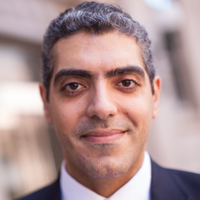The Johns Hopkins Bloomberg School of Public Health and the Johns Hopkins University School of Medicine are building a technology-based solution to tackle an ongoing challenge in cancer care delivery: effective transition of care (ToC). As Dr. Ahmed Hassoon, Co-Investigator with the Alliance to Advance Patient-Centered Cancer Care, explains, cancer patients often feel lost when they complete their active treatment; they move from intense monitoring and care to a destabilizing transition into survivorship. Studies have shown that patients in transition have a high risk of being readmitted to the hospital following their discharge, with rates of 26 percent for palliative medicine and 27 percent for general medical oncology.
A smooth transition of care requires extensive planning and allocating resources at the right time and the right place. While there are no universal standards of practice when planning a ToC program, essential tasks include verifying medication information, ensuring the patient understands and feels confident in their care plan, and following up after discharge. Electronic health records (EHR) can assist in this process, however, multiple reports indicate that clinical staff have serious concerns on the safety and usability of EHR tools. The most common complaint is that, in their current form, they can make accomplishing simple tasks an arduous process, which can negatively impact patient care.

Dr. Ahmed Hassoon and his multidisciplinary research team has been able to overcome these usability concerns, leveraging EHR to develop Transition of Care Plus (ToC+). This innovative software can provide solutions to augment care delivery by taking over redundant, rule-based decisions that would otherwise take up a lot of a care team’s time. The tool pulls data from patient’s medical records, then runs them through an algorithm to generate recommendations according to approved guidelines, as Dr. Hassoon explains: “Most of the information that we need is readily available as structured data in EHR. There is no need to re-enter this information. Other type of non-structured information can be pre-programed as choices, following well-established care patterns.” For instance, if a patient received a treatment that put them at higher risk for developing complications, ToC+ can assist the physician in developing a transition plan that includes focused surveillance at set intervals, freeing up time to focus on other tasks.
ToC+ aims to organize transitions, expectations, ownership & responsibility, identify high-risk patients, and save time. Dr. Hassoon is confident that the tool will help physicians by complementing their decision-making process, without taking over: “We don’t have to incorporate high cost sophisticated tools with imperfect accuracy. Our aim is the utility of the tool and not its sophistication. A good robust system that can handle redundant tasks will provide more quality time for providers to address cancer patients’ individual needs.”
 Ahmed Hassoon, MD, MPH, PMP
Ahmed Hassoon, MD, MPH, PMP
Research Associate
Cardiovascular and Clinical Epidemiology
Welch Center for Prevention, Epidemiology and Clinical Research
Johns Hopkins Bloomberg School of Public Health
